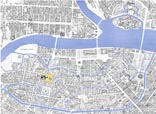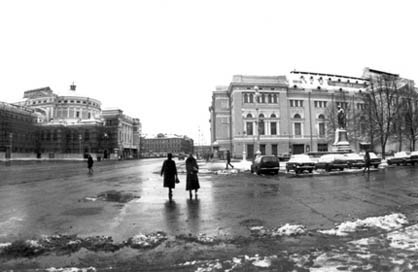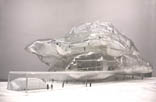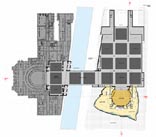|
|
|||||
| home > architetture | |||||
| ERIC
OWEN MOSS ARCHITECTS. Mariinsky Cultural Center/New Mariinsky Theatre |
|||||
| ARCH'IT
presenta i progetti sviluppati dallo studio di Eric Owen Moss per il
Nuovo Teatro Mariinski e per il New
Holland a San Pietroburgo, che il pubblico italiano ha potuto conoscere
all'interno del Padiglione Russo in occasione della scorsa Mostra di
Architettura della Biennale di Venezia. La sezione files ospita, con
una introduzione di Paola Giaconia, un intervento del progettista: in
Agli scultori del ghiaccio,
Eric Owen Moss raccoglie la sue impressioni sulla storica città e riassume
le sue intenzioni relative alla proposta progettuale. |
|||||
 |
The
Mariinsky Theatre and the Rimsky Korsakov Music Conservatory are among
the most prestigious cultural institutions of Russia. The Mariinsky
will be conserved and restored and a larger capacity New Mariinsky Theatre
will be built across the Krukov Canal. A glass bridge is proposed to
span the Krukov Canal and join the back stage of the existing theatre
with the rear stage production area of the New Mariinsky. |
[17jan2003] | |||
 Photo by Yuliya Larionova. A large entry plaza in the tradition of Palace Square connects the front of the new Mariinsky, the existing Mariinsky, and, by closing the street in front of the Rimsky Korsakov Conservatory, a pedestrian promenade joins all three venues. ORGANIZATION. The New Mariinsky is aligned on axis with the existing. Two opposing forces, the external constraints of the site and the internal programmatic needs of the theater, give shape to the three modules that define the requisite volumes of the theater. The surface of these modules is further differentiated in response to the severe climate. The resultant expression is that of an iceberg.  THEATRICAL SPACE. The interior surfaces of the three modules combine to form a grand theatrical space that is conceptually adjustable, moldable, and fluid. Using the volume of the existing theater as a point of departure, the main acoustic strategy of the new theater is to achieve the necessary acoustic requirements through adjustments in order to obtain the desired diffusion of sound and volume per seat ratios. A cylindrical concrete volume is inserted within the molded forms of the interior to complete the acoustic shell of the space. |
|
||||
   |
 COMPONENTS. The various elements of the theater are defined between the central concrete cylinder to the interior and the irregular surface of the modules to the exterior. The conceptually elastic surfaces of the modules are precisely adjusted to form and locate the structure, lobbies, concourses, and lecture spaces of the new theater. The outer surface of these modules consists of an irregular curved “resin” laminated slumped glass outer skin, and a faceted double-glazed inner skin that spans between solid, steel clad, roof elements and the concrete floors of the lobbies. |
 |
|||
   PROGRAM. The New Mariinsky is intended to be an expansion of the existing facilities. The public face of the theater shall include a 2,000 seat world-class theater, generous public lobbies, a separate lecture hall, theater shops, and a rooftop restaurant. The production area of the new facility shall accommodate 12 separate staging modules, each 16m x 16m x 14m, allowing the most complex assemblies and performance schedules, including the staging of four operas simultaneously. The existing theater will have access to these modules through a glass bridge proposed to span the Krukov Canal. Rehearsal halls, design and costume facilities, and administrative offices will also be housed in the new structure. |
 |
||||
| ERIC
OWEN MOSS ARCHITECTS. Mariinsky Cultural Center/New Mariinsky Theatre |
|||||
| location: St. Petersburg, Russia developer: Samitaur Constructs principal architect: Eric Owen Moss project team: Scott Nakao, Dolan Daggett, Eugene Slobodyanuk, Raul Garcia, Jose Herrasti, Sophie Frank, Emil Mertzel, Eric McNevin, Chuck Hellwig, Elena Andrews, Sharon Judelman, John Bencher, Paul Groh, Farshid Gazor, Reza Bagherzadeh, Pierpaolo Granata, Paolo Volpis, Brooke Luddock, Yaron Naim, Oliver Dering project: 2001 |
|||||
|
Eric Owen Moss
started his office in 1973 in Los Angeles, California, having received
his B.A. (English) from UCLA in 1965, M. Arch. in 1968 from UC Berkeley,
and M.Arch. in 1972 from Harvard's Graduate School of Design. He is
best known for reinventing spaces for commercial uses and performing
arts facilities, breathing new life into a marginal area in the celebrated
sequence of buildings in Culver City's Hayden Tract. Named "top architect
of a new generation" and "the jeweler of junk" by eminence gris Philip
Johnson, Moss pays careful attention to detail, both in terms of the
way things are put together, and the materials they are made from.
As N.Y. architect Charles Gwathmey stated in the 1999 awards ceremony
of the American Academy of Arts and Letters, "the architecture of
Eric Owen Moss is highly original. The forms and spaces embody a poetic
vision, enriched by a rigorous tectonic commitment. The buildings
are resonant and inspiring, and through their inventive presence,
establish a sense of pertinent place." The work includes university
facilities, office buildings, corporate headquarters, cultural institutions,
theaters, galleries, exhibition spaces, restaurants, urban public
space, housing, and private residences. Moss received the AIA/LA Gold
Medal in 2001, and his work has received numerous Progressive Architecture,
AIA, and AIA/LA design awards and has been widely published. He has
taught at all the leading U.S. schools of architecture, including
SCI-Arc, Harvard, Yale, Rice, Columbia, UCLA, and USC and is currently
director of SCI-Arc, Southern California Institute of Architecture. |
|||||
|
>
ERIC OWEN MOSS ARCHITECTS |
|||||
|
Per
candidare progetti laboratorio
|
|||||